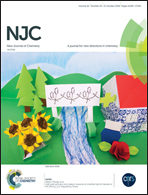A multi-analyte responsive chemosensor vanilinyl Schiff base: fluorogenic sensing of Zn(ii), Cd(ii) and I−†
Abstract
6,6′-((1E,1′E)-((2E,2′E)-((2-hydroxy-5-methyl-1,3-phenylene)bis(methanylylidene))bis(hydrazine-2,1-diylidene))bis(methanylylidene))bis(3-methoxyphenol). (H3L) is a multi-responsive vanilinyl-p-cresol diformyl Schiff base fluorescent chemosensor for Zn2+ (λem, 545 nm), Cd2+ (λem, 560 nm) (both in 9 : 1 (v/v) DMSO–water), and I− (λem, 630 nm in THF). The probe (H3L) is spectroscopically characterised and the chemosensing mechanism is demonstrated through 1H NMR, ESI-MS, absorption and luminescence spectral data. The most promising advantage of the probe (H3L) is its application in the one-pot detection of Zn2+ and Cd2+ using excitation at the same wavelength (λex, 482 nm) while highly intense emission appears at two different wavelengths. A detection kit is designed for drinking water analysis and has been checked to measure the quality of potable water in the locality. The sensor is also applied to construct an INHIBIT logic gate. Density Functional Theory (DFT) calculations are used to optimize the structure and the electronic properties are correlated with the experimental results.



 Please wait while we load your content...
Please wait while we load your content...